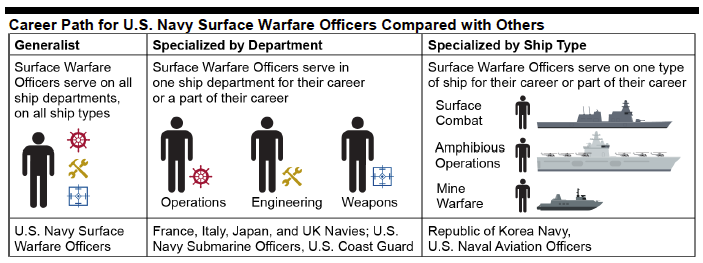The following is the Government Accountability Officer June 17, 2021 report, Navy Readiness: Actions Needed to Evaluate and Improve Surface Warfare Officer Career Path
From the report
SWOs are U.S. Navy officers whose primary duties focus on the safe operation of surface ships at sea. In 2017, the Navy had two collisions at sea that resulted in the death of 17 sailors and hundreds of millions of dollars in damage to Navy ships. Following the collisions, the Navy identified deficiencies in the SWO career path and staffing policies, and took action to improve these areas.
The John S. McCain National Defense Authorization Act for Fiscal Year 2019 contained a provision that GAO assess issues related to the U.S. Navy SWO career path. Among other things, this report (1) assesses trends in separation rates of SWOs with those of similar U.S. Navy officer communities, and trends in SWO separation rates by gender; (2) describes how the career path of U.S. Navy SWOs compares to those of selected foreign navies and other U.S. Navy and U.S. maritime communities; and (3) assesses the extent to which the U.S. Navy has used or evaluated alternative career paths. GAO analyzed U.S. Navy officer personnel data; selected foreign navies and U.S. maritime officer communities for comparison; and surveyed a generalizable sample of Navy SWOs.
What GAO Recommends
GAO is making 7 recommendations to the Navy, including developing a plan to improve SWO retention; regularly evaluating its current approaches, including alternative career paths; and using these to improve SWO career options and proficiency. The Navy concurred with GAO’s recommendations.
What GAO Found
U.S. Navy Surface Warfare Officers (SWOs) separate from the SWO community earlier and at higher rates compared with officers in similar U.S. Navy communities, and female SWOs separate at higher rates than male SWOs.

GAO found that after 10 years of service, around the first major career milestone:
- 33 percent of SWOs remain in their community, compared with 45 percent of officers from similar U.S. Navy officer communities, and
- 12 percent of female SWOs remain in their community, compared with 39 percent of male SWOs.
By using existing information to develop a plan to improve SWO retention, the Navy will be better positioned to retain a diverse and combat-ready community.
The career path for U.S. Navy SWOs differs from those in similar positions in selected foreign navies and other U.S. Navy and U.S. maritime communities.

The U.S. Navy made incremental career path changes for SWOs following the 2017 collisioNaval Aviation Warfighting Development Center, Naval Surface and Mine Warfighting Development Center, Surface Warfare Advanced Tactical Trainings, but has not regularly evaluated or fundamentally changed its SWO career path for over a century. GAO found that by a factor of four to one, SWOs believe specialized career paths would better prepare them for their duties than the current generalist career path. Without periodic evaluations of current approaches, including alternative career paths, and the use of those evaluations, the U.S. Navy may miss an opportunity to develop and retain proficient SWOs.
Download the document here.





